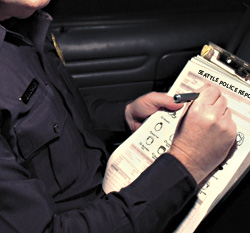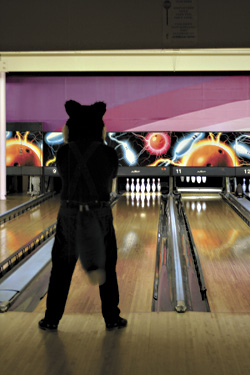Police work requires an affinity for high-speed chases and knocking heads. But it also demands a knack for prose. When the dust clears, an officer grabs an incident report form and crafts a story of what just occurred, be it car theft, robbery, or rape.
But this literary component of policing is about to receive a shake-up: On Jan. 9, the Seattle Police Department will switch to a new records-management system as part of its Seattle Police Information Dispatch and Electronic Reporting (SPIDER) project.
These newfangled forms feature a swarm of checkboxes that obviate the need for descriptive storytelling. For suspect descriptions, there are 35 boxes to check for language (Polish, Bengali, Tigrinia, sign language, etc.) and 10 boxes for “gang validation” (including gang dress, tattoos, and known hangouts). There are boxes devoted to 12 types of weapons and three types of handedness (left, right, and ambidextrous), as well as four discreet sections of checkboxes that deal with hair—there are 32 styles of head hair (including Afro, balding, bob, jheri curl, punk, messy, toupee/wig), 14 facial-hair types (such as fuzz, mutton/lamb chops, soul patch/Fu Manchu), and 13 colors for each (brown, blue, pink, auburn, blond/strawberry, etc.) Other forms handle property loss, vehicle identification, and crime location in a similar itemized fashion.
“You still have to tell the story,” says Deputy Chief Clark Kimerer, “but we certainly have found that when you’re so heavily dependent on a narrative, the ability to get intelligence and data out to identify patterns of crimes and do some prevention work can be a little bit daunting.”
The SPIDER project will also update the old method of note-taking for what will eventually become a paperless product; 800 officers will receive laptops early next year, says Kimerer. They’ll use their computers to generate reports in the field, before electronically transmitting them to supervisors.
Officers are field-testing the new forms now. But already, there have been some complaints. For example, without laptops issued yet, cops must write down information at the scene and then travel back to their precincts to enter it into whatever computer is available. “I went in for an officer-involved shooting,” says Sgt. Richard O’Neill, president of the Seattle Police Officers’ Guild. “It looked like the entire watch was in the precinct waiting to get to a computer. It’s like, ‘I got it next!'”
Also, the new forms can be substantially longer than the old ones. Two to three pages were enough to cover a simple incident with the old format, says O’Neill, whereas now a similar event might merit “upwards of six and eight pages,” he says. Combine that with the pain of adjusting to an excruciatingly detailed format, and frustration can grow high. “I won’t sugarcoat it,” says Kimerer. “We probably have a few officers that have threatened to throw Bill Gates products against the wall.”







